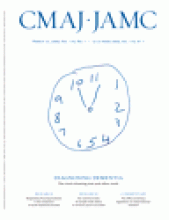- © 2008 Canadian Medical Association
The first symptom Jessica McPherson noticed was a weakness in her arms. Then her muscles began to twitch. She feared the worst, suspecting it might be amyotrophic lateral sclerosis, a fatal neurological disorder also known as Lou Gehrig disease. But her family doctor provided a much less grim diagnosis: medical school syndrome.
The tendency of medical students to diagnose themselves with diseases they are studying is well known. McPherson, then a first-year medical student at the University of Ottawa, realized her symptoms were psychosomatic and they soon disappeared. “I knew, rationally, it sounded crazy,” says the 27-year-old, now in the second year of her studies. “But I was pretty convinced.”
Although some might consider medical school syndrome trivial, even comical, mental health experts insist it's no joke. Imagined health problems can cause real anxiety; students patronized for revealing them may hesitate to seek care under any circumstance. This would not bode well for the medical profession, as doctors are already notoriously reluctant to become patients.
References to medical school syndrome, also called medical students' disease or medicalstudentitis, date back nearly a century. Boston neurologist Dr. George Lincoln Walton described the condition in his 1908 book Why Worry? “Medical instructors are continually consulted by students who fear that they have the diseases they are studying … The mere knowledge of the location of the appendix transforms the most harmless sensations in that region into symptoms of serious menace.”
Studies from the 1960s suggest that more than 70% of medical students contract phantom illnesses (J Nervous Mental Dis 1964;130:147-52 and J Med Educ 1966;41:785-90). More recent research, however, indicates the phenomenon has been exaggerated. In a 1986 study medical students were found no more likely to be hypochondriacs than law students (Arch Gen Psychiatry 1986;43[5]:487-89). Authors of a 2001 paper on the topic claim first-year medical students are hyperaware of their health but that it should be considered a normal effect of their education, not a form of hypochondriasis (J Med Educ 2001;35[8]:724–8).

There are occasions when a medical student's self-diagnosis, unfortunately, proves to be accurate, says Dr. Derek Puddester, director of the wellness program at the University of Ottawa's medical school. Image by: Roger Collier
Although some students with post-lecture maladies seek help, many don't. But in some cases they should, says Dr. Derek Puddester, a psychiatrist and director of the wellness program at the University of Ottawa's medical school. “If people are becoming very preoccupied with something they heard and it's bothering them, they need to see their family doctor.”
Puddester often hears from medical students and doctors who fear they have cancer or bipolar disorder or some other illness. The most common question he hears is: “Am I depressed?” He takes each concern seriously, as some self-diagnoses, unfortunately, prove correct.
Even students whose worries are unfounded need a safe place to discuss them, says Puddester. Otherwise, they are more likely to ignore real problems that arise later. And the last thing the medical profession needs is more physicians who refuse to enter a doctor's office that isn't their own. “Healthy doctors practise healthier medicine.”
It is not uncommon for medical students to have adverse reactions to certain aspects of their training, says Dr. Brian Hodges, a psychiatrist and director of the University of Toronto Donald R. Wilson Centre for Research in Education. In a 2004 paper he cited 2 examples: medical school syndrome and dissection anxiety, the mental distress some students suffer after dissecting a human cadaver for the first time — an experience known to induce nightmares (JCT 2004;20[2]:41-51).
To fortify their students' mental and emotional well-being, medical schools are increasingly adopting practices intended to lessen the effects of potentially traumatic experiences. Some programs cremate the remains of cadavers and hold burial services. Others encourage students to record their emotional responses to curriculum in journals. But such practices are not yet widespread. “We don't normally think about or treat people because of the way they react to an educational experience,” says Hodges.
McPherson's experience attests to that. She had never even heard of medical school syndrome before last year. Looking back, she can find humour in the incident but her fears were very real at the time. Originally from London, Ont., she believes the stress of moving to a new city and the exhaustion that comes with intense study contributed to her episode, along with the sudden immersion into the academics of biology and disease. “You're spending your days paying really close attention to science and symptoms. I think you become very aware of your body.”
Second-year medical students still diagnose themselves on occasion, says McPherson, but they are less likely to jump to conclusions. Still, she expects medicalstudentitis to pop up again in her life, though not in the same way. “I want to do family medicine, so I'm expecting to see a few cases of medical school syndrome after I graduate.”











